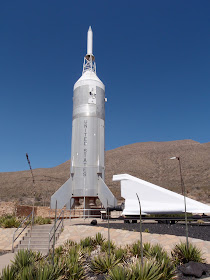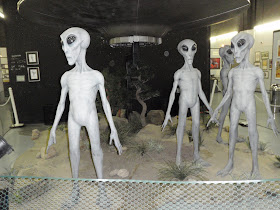Having spent a week in New Mexico I would like to challenge Montana’s claim to the nickname "Big Sky Country". After all, New Mexico is the state where rockets were launched and the atomic bomb detonated, where missiles are tested at White Sands Missile Range, where the sun is photographed every minute of every day from the National Solar Observatory, where the Very Large Array of satellite dishes keeps an ear to the sky, where an alien spaceship is said to have landed nearly 66 years ago. Yes, there’s a lot of sky and outer space to be studied, launched into, and even visited from in our nation’s 5th largest state.
****
****
The New Mexico Museum of Space History is my first space-related stop. The four story museum’s mission is to educate visitors about the historic and scientific aspects of space and the U.S. space program. Outside the museum a collection of rockets, boosters and missiles point toward the New Mexico sky—all are actual pieces and not replicas. A Mercury space capsule at the museum’s entrance entices visitors to sit inside its cramped confines and imagine themselves as one of the first six U.S. astronauts to journey into space.
 |
| Outdoor rocket display at The New Mexico Museum of Space History. |
 |
| A Mercury Space Capsule—not much bigger than the astronaut who rode in it. |
****
If you had the chance to visit a town called Sunspot, would you go? I think you would. A mountainous 16 mile drive from the town of Cloudcroft in south-central New Mexico leads to Sunspot and The National Solar Observatory. Here is a place dedicated to studying the sun. During the summer researchers from all over the world make Sunspot their home.
If you had the chance to visit a town called Sunspot, would you go? I think you would. A mountainous 16 mile drive from the town of Cloudcroft in south-central New Mexico leads to Sunspot and The National Solar Observatory. Here is a place dedicated to studying the sun. During the summer researchers from all over the world make Sunspot their home.
The self-guided tour takes visitors through a spruce-pine forest to the buildings which house the sun-spying telescopes. One of them—the Tower Telescope—is 390 feet long, two-thirds of which is buried underground. Kind of like an iceberg. The long scope uses mirrors and lenses to take pictures of the sun every minute of every day. This is the place to be if you want to be in the know on the latest solar happenings.
The observatory's museum was full of fun facts about the sun, such as this one: If you harnessed the power of the sun in one lightbulb the bulb would contain 235 million, billion, billion watts–or some incredible number like that.
 |
| Keeping an eye on the sky: The Tower Telescope. |
****
In Roswell the big draw is the International UFO Museum and Research Center. The museum documents the July 1947 crash of a UFO near Roswell and the finding of little green men (people) from the ship. The museum details reports of the crash sighting, U.S. Air Force findings and their subsequent “cover-up”. It’s all here. A research library in the museum provides further reading on the topic. The museum is entertaining, if nothing else.
Is there life on other planets? Maybe so. But I’m doubtful that the first contact with extraterrestrial life occurred here. How about you?
 |
| What do you think? Did this really happen? |
 |
| This exhibit shows the likenesses of the aliens discovered after the crash. |
 |
| The UFO Museum contains a bit of humor too. |
Also in Roswell is the Roswell Art Center and Museum. The Museum showcases New Mexico artists and tells the story of Robert Goddard—Roswell’s most famous resident and the father of modern rocketry. A Robert Goddard planetarium features daily showings of all-things-rocket. This is a worthwhile stop on anyone’s trip through Roswell.
****
How about it readers? Are you convinced that New Mexico is indeed “Big Sky Country"? Perhaps Montana should cede its nickname to New Mexico’s enchanted skies.
****

Rita, I very much enjoyed this posting. It was very informative, especially since I was totally unfamiliar with places such as the New Mexico Museum of Space History, and the National Solar Observatory. I have heard about the International UFO Museum and Research Center in Roswell. However, I don't ever recall seeing a photo showing the statue-like figures which depict the likeness of aliens said to have been discovered at the crash site.
ReplyDeleteThanks for sharing this!
John
You're welcome John!
ReplyDeleteI was as surprised as you to find such gems in New Mexico as the Museum of Space History and the Solar Observatory. During my weeklong trip to the state I had a rough itinerary, and neither of those two places were on it. When I arrived in Cloudcroft and picked up a brochure about Sunspot and the Solar Observatory, I knew I had to set aside a morning to tour it.
I thoroughly enjoyed all of the New Mexico museums I toured; they were interesting and informative. So glad you found this post informative as well!
Hi Rita,
ReplyDeleteThis one is right up my alley: science fact and science fiction all rolled into one!
I'd love to tour these spots in New Mexico (which I didn't realize, until I read it here, is the 5th largest state!). I bet the sky-scapes - sunrise and sunset - are pretty spectacular here, too. (Sorry, Montana!)
Looks like you had a beautiful day for touring Sunspot. I'm sure it was fascinating.
When I visited Bandelier National Park, I drove over to Los Alamos and the Bradbury Science Museum, which provides a history of the Manhattan Project. I'd love to see all those old spacecraft and even the UFO exhibitions. Roswell has been the jumping off point for so much of my favorite sci-fi stories, from "The X-Files" to the movie "Paul," and it would be fun to tour around this fabled area!
Thanks for bringing it to life.
I like the way you put it Vickie—"science fact and science fiction"—that describes this post to a "T"!
ReplyDeleteI have not been to Bandelier or to Los Alamos; I'll put both of those places on the itinerary for my next New Mexico trip.
I'm always appreciative of your thoughtful comments, Vickie!
Hi Rita,
DeleteI think you guys would love Bandelier - it's part of what's called The Grand Canyon of New Mexico, stunning canyons and cave formations cut into the sandstone over millions of years. The sandstone in Bandelier is pink and the ancient Anasazi and other populations carved caves out of this soft rock high up in the cliffs. It's a great tour with a helpful visitor's center to ground yourself in the history and archeology.